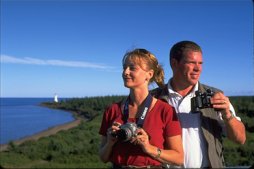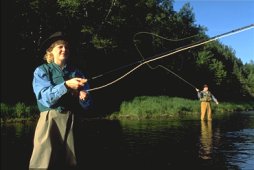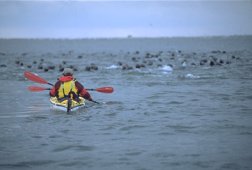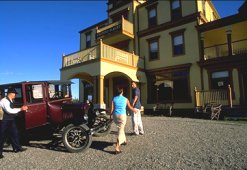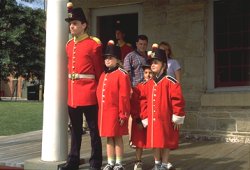
|
|||||||||||||||

|
|||||||||||||||
New Brunswick, Canada
|

|
||||||||||||||
The wonderful St. John River, often referred to as The Rhine of North America, creates a province-long valley. Miramichi, Restigouche, Nepisiguit, Salmon, St. Croix and Tobique rivers are popular with water sportsmen such as anglers, white-water rafters and sailors. Grand, Chiputneticook, Magaguadavic and Oromocto lakes are always good for an outdoor adventure. Visitors to New Brunswick find natural wonders such as the world’s highest tides of the Bay of Fundy that have carved a spectacular coastline, one of the last pristine sand dunes on the eastern shores of North America and a peaceful ocean retreat at the Fundy Isles.
New Brunswick is home to 2.400 kilometres of breathtaking coastline and one of the last great sand dunes on the northeastern coast of North America. This dune is preserved in the 12-kilometre Irving Eco Centre, La Dune de Bouctouche, providing a sanctuary for migratory shorebirds and nesting grounds for the endangered piping plover. The eastern shore with the gentle waters of the Northumberland Strait offers warm and sandy beaches and some of the best swimming beaches. Mount Carleton Provincial Park is home to the highest peak in the Maritimes (820 metres). Enjoy hiking this huge, undeveloped wilderness park with its sweeping vistas, endless hiking trails and pristine lakes. There are many trails to discover for backpacking or biking enthusiasts. For more information on New Brunswick’s Trails call the New Brunswick Trail Council at 1-800-526-7070. Go back in time and visit one of the pioneer villages; Kings Landing Historical Settlement near Fredericton, and Acadian Historical Village near Caraquet. New Brunswick is Canada’s only official bilingual province and Acadian culture is alive and present wherever you go. Visit old-time country churches, forts and museums and enjoy Acadian cuisine in seaside cafés, street side bistros and exclusive restaurants. New Brunswick in Figures New Brunswick has a population of about 757,000 people (July 2000). With 33 per cent of the population being French speaking, New Brunswick is Canada's only official bilingual province. New Brunswick covers an area of 73,440 sq km 85 per cent of which is forested. The province of New Brunswick is about 242 kilometres (150 miles) from east to west and 322 kilometres (200 miles) north to south. Fredericton is the capital of New Brunswick with about 46,507 inhabitants Saint John is the province's oldest and largest city with a population of 72,494. Mt. Carleton, at 820 metres (2,690 feet), marks the highest elevation in New Brunswick. Arrival
Trans-Canada-Highway leads from Quebec to New Brunswick, linking the cities of Edmundston, Fredericton and Moncton with each other. It runs further east to the province of Nova Scotia. Highway 8 connects Fredericton with Miramichi and Bathurst. Highway 11 runs along the eastern coast, from Campbellton to Miramichi and further southeast to Shediac. The world-renowned Confederation Bridge connects New Brunswick to Prince Edward Island. Distances Bathurst to Fredericton 250 km (156 mi) Miramichi to Fredericton 172 km (107 mi) Moncton to Fredericton 170 km (106 mi) Saint John to Fredericton 114 km (71 mi) Climate New Brunswick offers a blend of climate typical of a coastal area and that of an inland province. Summers are usually not blisteringly hot and comfortable. Spring and fall bring many pleasant but cooler days. Winters usually are cold and bring lots of snow. August tends to be the driest month of the year. Means of payment Besides the most common credit cards (Visa, Master Card and American Express) you might consider carrying some Traveller's Cheques in Canadian currency and small denominations. Those are generally accepted like cash and have the advantage of being insured. However you should always carry some cash, especially if you intend to push forward to more rural areas. Here cash is the only thing that counts as most of the small shops do not have the equipment to accept credit cards. You should not bring German Marks or American Dollar in order to pay your bills. Prices
We recommend saving all receipts, as tourists who have their place of residence outside of Canada might be eligible for tax refund. However, this only applies for amounts over CAN $50,00 per receipt (except accommodation receipt where no minimum amount applies) and a minimum of CAN $200,00 in total. Not eligible for tax refund are bills paid for gas or transportation. In any case it might be worthwhile to save receipts for accommodations or larger purchases that are exported. The application for tax refund can be found at the website address shown below. You can file your application up to six months after you have left the country and has to be in writing. A refund cheque will than be mailed to your home address. If you came by plane you are required to send your bording pass with your application. Receipts for goods have to be validated by Canada Customs as you leave Canada. For further information visit Visitor Tax Refund. Opening Hours Usually stores in New Brunswick are open 10 am to 6 pm. Some might be open till 9 pm and grocery stores often offer a 24 hour service, which also applies to gas stations who regularly have a convenient store attached. In summer months usually longer opening hours apply. The post office generally closes at 5 pm, banks sometimes already at 4 pm. National Parks
For more information call (506) 876-2443 Fundy National Park  Location: Approx. 75 minutes southwest of Moncton on Hwy. 114. Fundy National Park is a 206 sq km park containing exhibits, self-guided trails, picnic areas and scenic viewpoints. The park is home to the world’s highest tides. Enjoy spectacular panoramic views of the Bay of Fundy; coastal cliffs and rolling forested hills. For more information call (506) 887-6000 Provincial Parks Mount Carleton Provincial Park Location: 43 km east of Saint Quentin on Highway 180. This 17,427-hectare park is the largest natural site in the province of New Brunswick offering a blend of mountains, valleys and rivers surrounded by wilderness. Main feature of the park is a series of peaks and ridges, including Mt Carleton. An extensive hiking trail system of approx. 62 km leads you to pristine lakes, superb fishing, canoeing and swimming. Camping sites available. For more information call (506) 235-0793 Historic Sites Acadian Historical Village 
Beaubears Island National Historic Site Location: On the Miramichi River, 90 minutes north of Moncton and 1 hour south of Bathurst. Access is only by private boat or charter! Beaubears Island has been used by the Mi’kmaq as camping site for many centuries. The Acadians lived on the island until deportation in 1755. English settlement followed. Today visitors to the island can enjoy the basic trail system and picnic facilities surrounded by natural beauty. For more information call (506) 876-2443 Carleton Martello Tower National Historic Site  Location: At 454 Whipple Street in Saint John. Carleton Martello Tower was built in 1814 and served a crucial role in the defence of Saint John and its harbour until WW II. Today, visitors can tour the unique architecture of this circular stone fort and enjoy a restored powder magazine; a restored barracks room, as well as exhibits in the tower. The tower offers an excellent viewpoint of the city of Saint John and its harbour. For more information call (506) 636-4011 Fort Beauséjour National Historic Site  Location: In Aulac, approx. 45 minutes southeast of Moncton, off Trans-Canada Highway. Fort Beauséjour is a star-shaped fort built in 1751 by French. It was taken by the British in a battle for control of Nova Scotia. Today you can visit the restored ruins of the fort. On site you will find a Visitor Reception Centre with exhibits. Enjoy the wonderful view of the Bay of Fundy. For more information call (506) 364-5080 Hartland Covered Bridge National Historic Site Location: Off Route 2 (TCH) between Routes 103 and 105. With 1,282-foot length, the Hartland Covered Bridge is the longest covered bridge in the world. It spans the beautiful St. John River and was officially opened July 4, 1901. If you cross the bridge, make sure you follow a New Brunswick tradition and make a wish as you cross it. Kings Landing Historical Settlement Location: 34 km west of Fredericton on Route 2, Exit 253, Prince William. Kings Landing Historical Settlement is a world-class living history museum in New Brunswick that re-creates life in rural New Brunswick in the 1800s. There are eleven historic homes, filled with antiques to enjoy. Step back in time and experience the cultural adventure of a lifetime! Kings Landing is fun and exciting for the whole family all summer long. For more information call (506) 363-4999 Monument Lefebvre National Historic Site  Location: In Saint-Joseph-de-Memramcook, a 30-minute drive southeast of Moncton, off Trans-Canada-Highway. Monument Lefebvre is a two-story structure from 1896 overlooking the scenic Memramcook Valley, commemorating the perseverance of the Acadians, who call this area home for more than three centuries. The historical building hosts a full range of cultural activities in its magnificent restored theatre. For more information call (506) 758-9783 Roosevelt Campobello International Park  Location: On the southern end of Campobello Island. Roosevelt Campobello International Park has a size of 1,134-hectare (2,800 acre) and is a magical and historical place, which U.S. President Franklin D. Roosevelt called his “Beloved Island”. His 34-room summer cottage and the grounds where he vacationed are preserved as a memorial and as a symbol of the close friendship between Canada and the United States. For more information call (506)-752-2922 St. Andrews Blockhouse National Historic Site  Location: 30-minute drive east of Calais, Maine, and one hour west of Saint John, off Hwy 127. St. Andrews Blockhouse dates back from the War of 1812, when townspeople built this blockhouse for border defence. It is the only original blockhouse in New Brunswick and offers a panoramic view of St. Croix River. The building was fully restored and furnished to its 1812 appearance after suffering a fire in 1993. For more information call (506) 529-4270 History
The 1800s saw booming lumber and shipbuilder industries. The depression brought an end to prosperity and the power started shifting more and more to central Canada. It was not before the 1970, that New Brunswick could improve its infrastructure and diversify its economy. Today, lumber, pulp and paper as well as manufacturing are important industries. |
|||||||||||||||
Other province's & territories' Travel Tips
| Alberta | British Columbia | Manitoba | New Brunswick | Newfoundland & Labrador |
| Nova Scotia | Ontario | Prince Edward Island | Québec | Saskatchewan |
| Yukon Territory |


